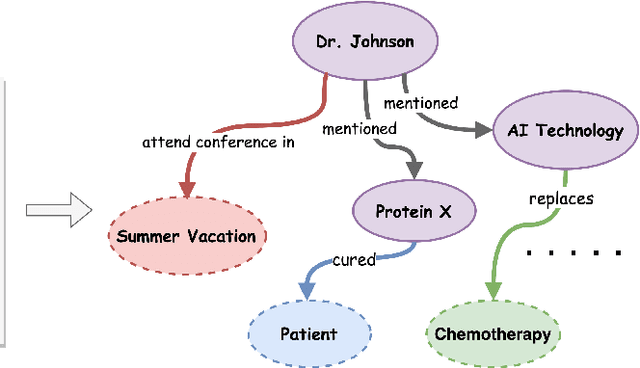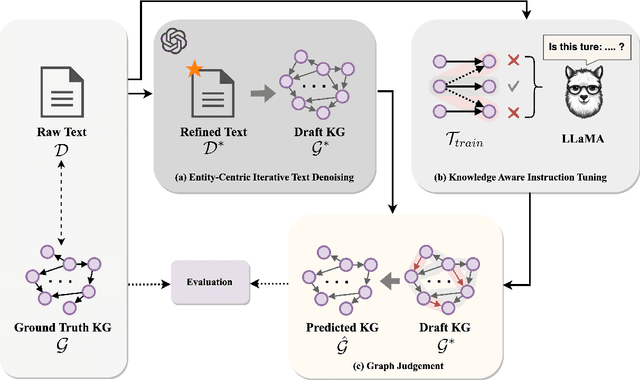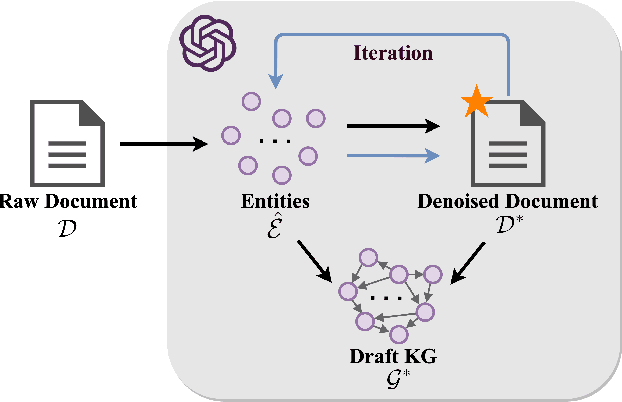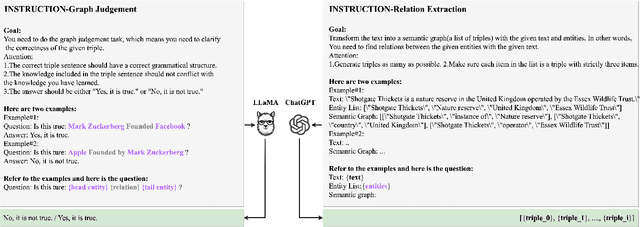Jiawei Jiang
Privacy-protected Retrieval-Augmented Generation for Knowledge Graph Question Answering
Aug 12, 2025Abstract:LLMs often suffer from hallucinations and outdated or incomplete knowledge. RAG is proposed to address these issues by integrating external knowledge like that in KGs into LLMs. However, leveraging private KGs in RAG systems poses significant privacy risks due to the black-box nature of LLMs and potential insecure data transmission, especially when using third-party LLM APIs lacking transparency and control. In this paper, we investigate the privacy-protected RAG scenario for the first time, where entities in KGs are anonymous for LLMs, thus preventing them from accessing entity semantics. Due to the loss of semantics of entities, previous RAG systems cannot retrieve question-relevant knowledge from KGs by matching questions with the meaningless identifiers of anonymous entities. To realize an effective RAG system in this scenario, two key challenges must be addressed: (1) How can anonymous entities be converted into retrievable information. (2) How to retrieve question-relevant anonymous entities. Hence, we propose a novel ARoG framework including relation-centric abstraction and structure-oriented abstraction strategies. For challenge (1), the first strategy abstracts entities into high-level concepts by dynamically capturing the semantics of their adjacent relations. It supplements meaningful semantics which can further support the retrieval process. For challenge (2), the second strategy transforms unstructured natural language questions into structured abstract concept paths. These paths can be more effectively aligned with the abstracted concepts in KGs, thereby improving retrieval performance. To guide LLMs to effectively retrieve knowledge from KGs, the two strategies strictly protect privacy from being exposed to LLMs. Experiments on three datasets demonstrate that ARoG achieves strong performance and privacy-robustness.
Guiding LLM-based Smart Contract Generation with Finite State Machine
May 13, 2025Abstract:Smart contract is a kind of self-executing code based on blockchain technology with a wide range of application scenarios, but the traditional generation method relies on manual coding and expert auditing, which has a high threshold and low efficiency. Although Large Language Models (LLMs) show great potential in programming tasks, they still face challenges in smart contract generation w.r.t. effectiveness and security. To solve these problems, we propose FSM-SCG, a smart contract generation framework based on finite state machine (FSM) and LLMs, which significantly improves the quality of the generated code by abstracting user requirements to generate FSM, guiding LLMs to generate smart contracts, and iteratively optimizing the code with the feedback of compilation and security checks. The experimental results show that FSM-SCG significantly improves the quality of smart contract generation. Compared to the best baseline, FSM-SCG improves the compilation success rate of generated smart contract code by at most 48%, and reduces the average vulnerability risk score by approximately 68%.
Exploiting Text Semantics for Few and Zero Shot Node Classification on Text-attributed Graph
May 13, 2025



Abstract:Text-attributed graph (TAG) provides a text description for each graph node, and few- and zero-shot node classification on TAGs have many applications in fields such as academia and social networks. Existing work utilizes various graph-based augmentation techniques to train the node and text embeddings, while text-based augmentations are largely unexplored. In this paper, we propose Text Semantics Augmentation (TSA) to improve accuracy by introducing more text semantic supervision signals. Specifically, we design two augmentation techniques, i.e., positive semantics matching and negative semantics contrast, to provide more reference texts for each graph node or text description. Positive semantic matching retrieves texts with similar embeddings to match with a graph node. Negative semantic contrast adds a negative prompt to construct a text description with the opposite semantics, which is contrasted with the original node and text. We evaluate TSA on 5 datasets and compare with 13 state-of-the-art baselines. The results show that TSA consistently outperforms all baselines, and its accuracy improvements over the best-performing baseline are usually over 5%.
RetroInfer: A Vector-Storage Approach for Scalable Long-Context LLM Inference
May 05, 2025Abstract:The growing context lengths of large language models (LLMs) pose significant challenges for efficient inference, primarily due to GPU memory and bandwidth constraints. We present RetroInfer, a novel system that reconceptualizes the key-value (KV) cache as a vector storage system which exploits the inherent attention sparsity to accelerate long-context LLM inference. At its core is the wave index, an Attention-aWare VEctor index that enables efficient and accurate retrieval of critical tokens through techniques such as tripartite attention approximation, accuracy-bounded attention estimation, and segmented clustering. Complementing this is the wave buffer, which coordinates KV cache placement and overlaps computation and data transfer across GPU and CPU to sustain high throughput. Unlike prior sparsity-based methods that struggle with token selection and hardware coordination, RetroInfer delivers robust performance without compromising model accuracy. Experiments on long-context benchmarks show up to 4.5X speedup over full attention within GPU memory limits and up to 10.5X over sparse attention baselines when KV cache is extended to CPU memory, all while preserving full-attention-level accuracy.
Modality Selection and Skill Segmentation via Cross-Modality Attention
Apr 20, 2025Abstract:Incorporating additional sensory modalities such as tactile and audio into foundational robotic models poses significant challenges due to the curse of dimensionality. This work addresses this issue through modality selection. We propose a cross-modality attention (CMA) mechanism to identify and selectively utilize the modalities that are most informative for action generation at each timestep. Furthermore, we extend the application of CMA to segment primitive skills from expert demonstrations and leverage this segmentation to train a hierarchical policy capable of solving long-horizon, contact-rich manipulation tasks.
Towards Scalable and Deep Graph Neural Networks via Noise Masking
Dec 19, 2024



Abstract:In recent years, Graph Neural Networks (GNNs) have achieved remarkable success in many graph mining tasks. However, scaling them to large graphs is challenging due to the high computational and storage costs of repeated feature propagation and non-linear transformation during training. One commonly employed approach to address this challenge is model-simplification, which only executes the Propagation (P) once in the pre-processing, and Combine (C) these receptive fields in different ways and then feed them into a simple model for better performance. Despite their high predictive performance and scalability, these methods still face two limitations. First, existing approaches mainly focus on exploring different C methods from the model perspective, neglecting the crucial problem of performance degradation with increasing P depth from the data-centric perspective, known as the over-smoothing problem. Second, pre-processing overhead takes up most of the end-to-end processing time, especially for large-scale graphs. To address these limitations, we present random walk with noise masking (RMask), a plug-and-play module compatible with the existing model-simplification works. This module enables the exploration of deeper GNNs while preserving their scalability. Unlike the previous model-simplification works, we focus on continuous P and found that the noise existing inside each P is the cause of the over-smoothing issue, and use the efficient masking mechanism to eliminate them. Experimental results on six real-world datasets demonstrate that model-simplification works equipped with RMask yield superior performance compared to their original version and can make a good trade-off between accuracy and efficiency.
Origin-Destination Demand Prediction: An Urban Radiation and Attraction Perspective
Nov 29, 2024Abstract:In recent years, origin-destination (OD) demand prediction has gained significant attention for its profound implications in urban development. Existing data-driven deep learning methods primarily focus on the spatial or temporal dependency between regions yet neglecting regions' fundamental functional difference. Though knowledge-driven physical methods have characterised regions' functions by their radiation and attraction capacities, these functions are defined on numerical factors like population without considering regions' intrinsic nominal attributes, e.g., a region is a residential or industrial district. Moreover, the complicated relationships between two types of capacities, e.g., the radiation capacity of a residential district in the morning will be transformed into the attraction capacity in the evening, are totally missing from physical methods. In this paper, we not only generalize the physical radiation and attraction capacities into the deep learning framework with the extended capability to fulfil regions' functions, but also present a new model that captures the relationships between two types of capacities. Specifically, we first model regions' radiation and attraction capacities using a bilateral branch network, each equipped with regions' attribute representations. We then describe the transformation relationship of different capacities of the same region using a hypergraph-based parameter generation method. We finally unveil the competition relationship of different regions with the same attraction capacity through cluster-based adversarial learning. Extensive experiments on two datasets demonstrate the consistent improvements of our method over the state-of-the-art baselines, as well as the good explainability of regions' functions using their nominal attributes.
Can LLMs be Good Graph Judger for Knowledge Graph Construction?
Nov 26, 2024



Abstract:In real-world scenarios, most of the data obtained from information retrieval (IR) system is unstructured. Converting natural language sentences into structured Knowledge Graphs (KGs) remains a critical challenge. The quality of constructed KGs may also impact the performance of some KG-dependent domains like GraphRAG systems and recommendation systems. Recently, Large Language Models (LLMs) have demonstrated impressive capabilities in addressing a wide range of natural language processing tasks. However, there are still challenges when utilizing LLMs to address the task of generating structured KGs. And we have identified three limitations with respect to existing KG construction methods. (1)There is a large amount of information and excessive noise in real-world documents, which could result in extracting messy information. (2)Native LLMs struggle to effectively extract accuracy knowledge from some domain-specific documents. (3)Hallucinations phenomenon cannot be overlooked when utilizing LLMs directly as an unsupervised method for constructing KGs. In this paper, we propose GraphJudger, a knowledge graph construction framework to address the aforementioned challenges. We introduce three innovative modules in our method, which are entity-centric iterative text denoising, knowledge aware instruction tuning and graph judgement, respectively. We seek to utilize the capacity of LLMs to function as a graph judger, a capability superior to their role only as a predictor for KG construction problems. Experiments conducted on two general text-graph pair datasets and one domain-specific text-graph pair dataset show superior performances compared to baseline methods. The code of our proposed method is available at https://github.com/hhy-huang/GraphJudger.
Retrofitting Temporal Graph Neural Networks with Transformer
Sep 10, 2024



Abstract:Temporal graph neural networks (TGNNs) outperform regular GNNs by incorporating time information into graph-based operations. However, TGNNs adopt specialized models (e.g., TGN, TGAT, and APAN ) and require tailored training frameworks (e.g., TGL and ETC). In this paper, we propose TF-TGN, which uses Transformer decoder as the backbone model for TGNN to enjoy Transformer's codebase for efficient training. In particular, Transformer achieves tremendous success for language modeling, and thus the community developed high-performance kernels (e.g., flash-attention and memory-efficient attention) and efficient distributed training schemes (e.g., PyTorch FSDP, DeepSpeed, and Megatron-LM). We observe that TGNN resembles language modeling, i.e., the message aggregation operation between chronologically occurring nodes and their temporal neighbors in TGNNs can be structured as sequence modeling. Beside this similarity, we also incorporate a series of algorithm designs including suffix infilling, temporal graph attention with self-loop, and causal masking self-attention to make TF-TGN work. During training, existing systems are slow in transforming the graph topology and conducting graph sampling. As such, we propose methods to parallelize the CSR format conversion and graph sampling. We also adapt Transformer codebase to train TF-TGN efficiently with multiple GPUs. We experiment with 9 graphs and compare with 2 state-of-the-art TGNN training frameworks. The results show that TF-TGN can accelerate training by over 2.20 while providing comparable or even superior accuracy to existing SOTA TGNNs. TF-TGN is available at https://github.com/qianghuangwhu/TF-TGN.
Hound: Hunting Supervision Signals for Few and Zero Shot Node Classification on Text-attributed Graph
Sep 01, 2024



Abstract:Text-attributed graph (TAG) is an important type of graph structured data with text descriptions for each node. Few- and zero-shot node classification on TAGs have many applications in fields such as academia and social networks. However, the two tasks are challenging due to the lack of supervision signals, and existing methods only use the contrastive loss to align graph-based node embedding and language-based text embedding. In this paper, we propose Hound to improve accuracy by introducing more supervision signals, and the core idea is to go beyond the node-text pairs that come with data. Specifically, we design three augmentation techniques, i.e., node perturbation, text matching, and semantics negation to provide more reference nodes for each text and vice versa. Node perturbation adds/drops edges to produce diversified node embeddings that can be matched with a text. Text matching retrieves texts with similar embeddings to match with a node. Semantics negation uses a negative prompt to construct a negative text with the opposite semantics, which is contrasted with the original node and text. We evaluate Hound on 5 datasets and compare with 13 state-of-the-art baselines. The results show that Hound consistently outperforms all baselines, and its accuracy improvements over the best-performing baseline are usually over 5%.
 Add to Chrome
Add to Chrome Add to Firefox
Add to Firefox Add to Edge
Add to Edge